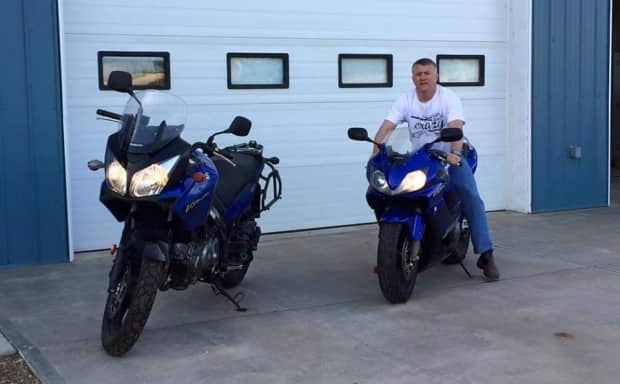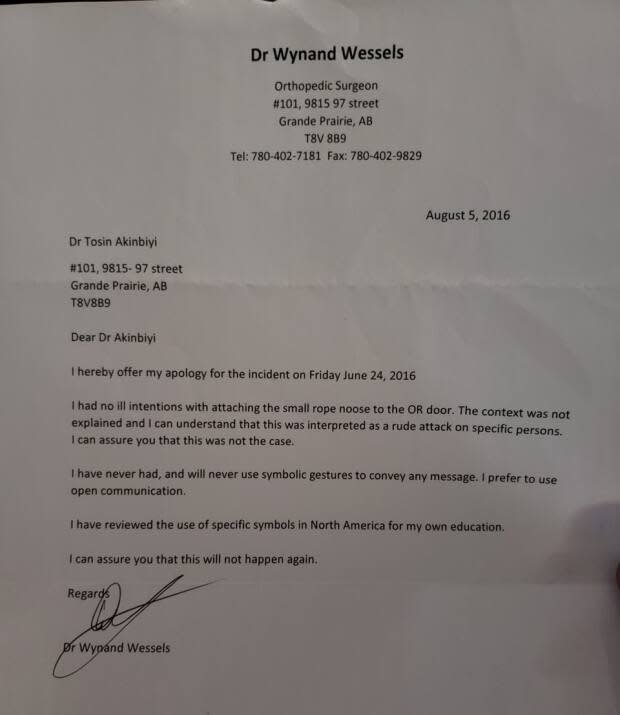Grande Prairie surgeon denies targeting Black colleague with noose
A white Grande Prairie surgeon denies he targeted a Black surgical assistant in June 2016 by tying a noose and then taping it to the operating room door at Grande Prairie's Queen Elizabeth II Hospital.
Orthopedic surgeon Dr. Wynand Wessels told a disciplinary hearing of the College of Physicians and Surgeons of Alberta on Friday the noose was intended to symbolize a team-building exercise similar to one he engaged in while he was a boy scout growing up in rural South Africa.
Wessels, through his lawyer, admitted creating the noose and he admitted it was a breach of the college's code of conduct. But he strongly denied the noose was intended to be racist or to target or intimidate any person or group.
Testifying under oath, the surgeon said that because of restrictions placed on outside media by the South African government, he grew up not knowing the North American significance of the noose as a symbol to terrorize and intimidate Black people by evoking lynching.
The noose in South Africa, Wessels said, doesn't carry the same racist connotation as it does in other places. He said the noose was an attempt at humour.
"It was light-hearted; it was nothing sinister," he said.
The surgeon denied he told colleague Dr. Scott Wiens — shortly after he taped the noose to the door — that it was aimed at Dr. Oduche Onwuanyi, a Nigerian-born Black surgical assistant.
Wessels' lawyer, James Heelan, led evidence in which Wessels described a dysfunctional culture at the Grande Prairie hospital, particularly among the orthopedic surgeons.
He said the surgeons had split into two fractious camps, with one led by the two surgeons — doctors Wiens and Tosin Akinbiyi — who formally complained about the noose.
Wessels described a strained relationship with Wiens.
He accused Wiens of creating "discord" at the hospital and claimed Wiens frequently engaged in a "deliberate attempt to undermine" any new practices.
And he said Onwuanyi did not appear to be "aggressively unhappy" about the incident when Wessels approached him later that day.
Incident repeatedly reported to health officials
Onwuanyi, Wiens, and Akinbiyi could not contradict Wessels' version of events. The college did not call them as witnesses. Nor did they summon any other staff with direct knowledge of the incident or the culture at the hospital.
Heelan and others involved in the hearing mispronounced Onwuanyi's name throughout the proceeding, often in several different ways.
The college did not immediately respond to questions about these issues.
Onwuanyi earlier this week declined an interview request from CBC News and he did not watch today's hearing, which was conducted remotely due to the pandemic.

In July, CBC News first published a story about the noose incident. In an interview, Wiens said Wessels had told him the noose was meant for Onwuanyi.
Wiens photographed the noose on the door, removed it and, along with a colleague, complained to hospital administration.
Friday's hearing came after what sources have described as years of inaction by the hospital's administration, Alberta Health Services (AHS) and the college, who were repeatedly told about the incident.
In August 2019, a doctor reported the incident to Health Minister Tyler Shandro, but said she heard nothing back.
After CBC News contacted Shandro for comment, the minister ordered a third-party independent investigation into AHS' handling of the incident, maintaining department officials repeatedly assured him the health authority and the CPSA were separately handling the matter.
Noose part of 'inside joke' about work environment: surgeon
Wessels on Friday testified that while at the hospital on the morning of June 24, 2016, a nurse complained to him about the lack of teamwork and discipline among the orthopedic surgery group.
During the conversation, Wessels said, he began playing with a piece of rope on a nearby medical cart, eventually fashioning it into the noose.
He likened the noose to a lasso-like knot used in the boy scouts to tie together children who refused to work together. He said he explained this to the nurse, which she confirmed in a statement to the college's investigator. Wessels admitted he subsequently taped the noose to the operating room door. Both he and his lawyer, James Heelan, repeatedly characterized this action as part of an "inside joke" between Wessels and the nurse about the lack of collaboration among staff.
The surgeon did not explain why he then taped it in a place where others could clearly see it — including Onwuanyi, who Wessels admitted he knew was one of two doctors working that day in that specific operating room.
Wessels also admitted under cross-examination that he knew, even while studying as a medical student in South Africa, that the noose was used to execute prisoners there. He said he has since educated himself on the racist history of the noose.
During the hearing, Wessels' lawyer repeatedly characterized the noose as a "lasso," despite the fact Wessels himself referred to it as a "small rope noose" in a 2016 apology letter and often called it a noose during Friday's hearing.
Wessels testified that when Wiens saw the noose and asked if it was for Onwuanyi, he replied that it was for anyone who was misbehaving, including Onwuanyi.

Shortly after, colleagues pointed out the racist and violent symbolism of the noose, at which point he went to hospital administration, he said.
Wessels testified a local Alberta Health Services executive told him that to "close" the matter he had to write a letter of apology to the two doctors — Wiens and Akinbiyi — who were concerned about the noose, which he did.
Surgical assistant said he perceived noose as a threat
Wessels did not apologize to Onwuanyi because he said his colleague generally accepted his explanation that it wasn't racist, and was not meant to target him.
But the hearing's chair read from a letter Onwuanyi sent to the college's associate complaints director in which Onwuanyi said, "I did not have an open discussion with Dr. Wessels regarding this incident."
Onwuanyi replied to a college investigator's question about how he perceived the noose by saying he thought it was "a threat, a racial insult, a slur directed at Black persons" that was meant to intimidate and symbolize a threat to life.
"It was also seen as a hangman's noose, the main object used in segregation-era lynching, and was an illegal object internationally."

At one point during the hearing, the chair asked Wessels if he recognized any "real or perceived power imbalance" between himself and Onwuanyi, the surgical assistant.
"I do not really see the power imbalance," Wessels replied, saying the two work as a team and "I am definitely not above him."
Craig Boyer, the lawyer who presented the college's case, told the hearing the noose may have been directed at Wiens rather than Onwuanyi, despite the fact there was no evidence in the agreed exhibit book or testimony from Wessels that supported this theory.
Since Wessels has admitted he breached the college's code of conduct, the hearing panel will only need to decide what, if any, penalty he should receive. The all-white, three-person panel will issue a written decision but it gave no indication of when.
Wessels' lawyer downplayed the incident as a "foolish joke for which Dr. Wessels is paying a significant price."
If you have information for this story, or information for another story, please contact us in confidence at cbcinvestigates@cbc.ca.

